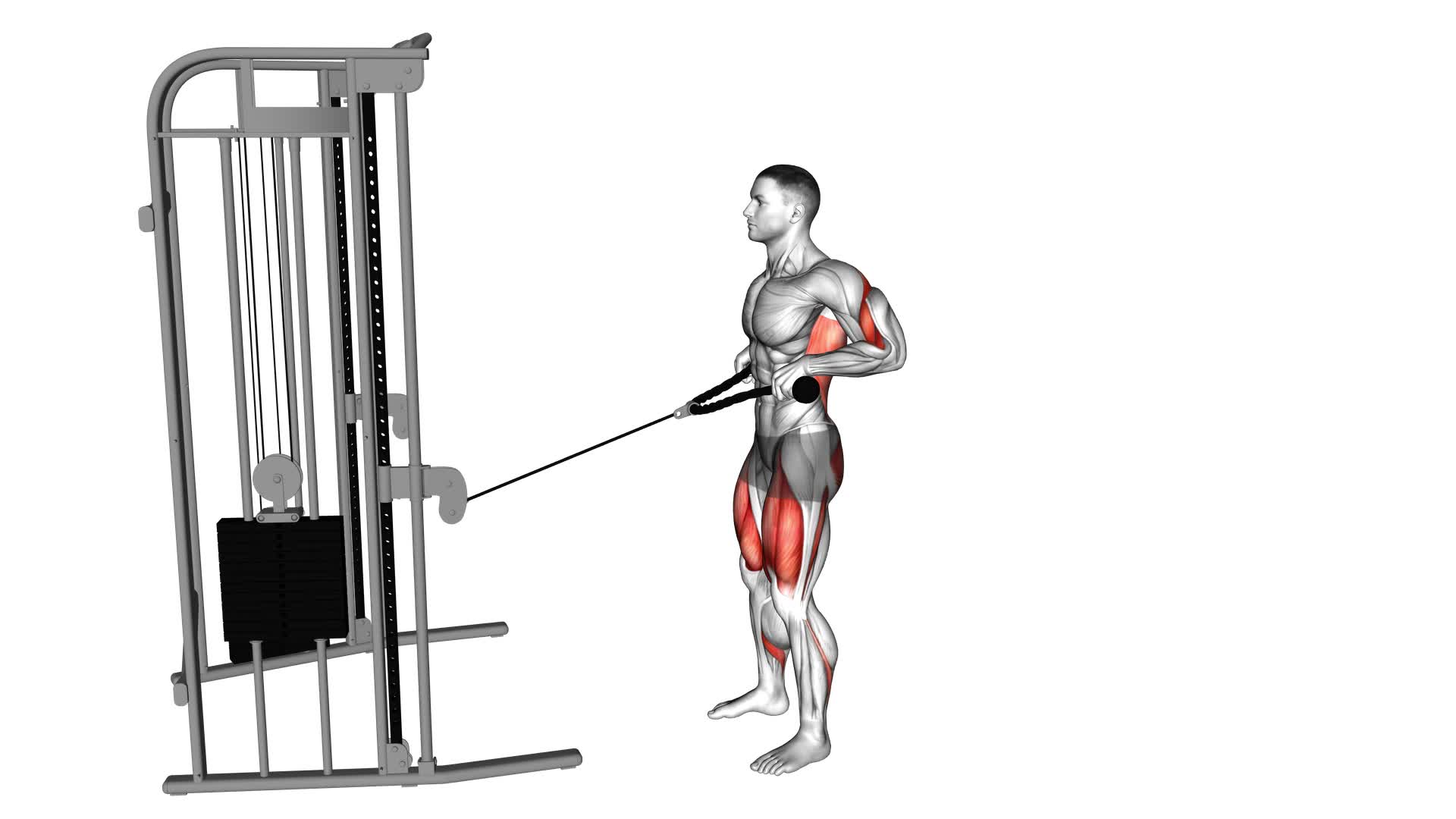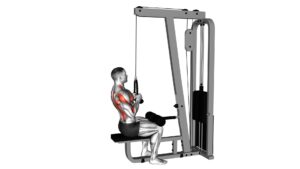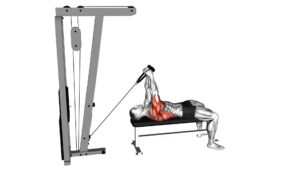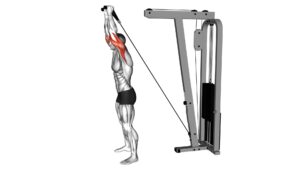Cable Squat Row (With Rope Attachment) – Video Exercise Guide & Tips

In this video exercise guide, you'll learn how to do the Cable Squat Row with a rope attachment.
Watch This Exercise Video
This exercise offers a range of benefits for your upper body and lower body strength.
You'll need a cable machine and a rope attachment to perform this move.
Follow our expert tips to ensure proper form and avoid common mistakes.
Plus, we'll share some valuable tips to help you increase the intensity of your Cable Squat Row.
Let's get started!
Key Takeaways
- Cable squat row targets multiple muscle groups.
- It strengthens and develops the latissimus dorsi (back muscles).
- The exercise engages the muscles of the lower body, including the quadriceps, hamstrings, and glutes.
- It also activates core muscles, such as the abdominals and obliques.
Benefits of Cable Squat Row
You can gain strength and improve your overall fitness by incorporating cable squat row variations into your workout routine. The cable squat row is a compound exercise that targets multiple muscle groups, making it an effective and efficient way to work your entire body.
One of the main benefits of the cable squat row is that it targets the back muscles, specifically the latissimus dorsi or lats. These muscles are responsible for pulling movements, and by performing cable squat rows, you can strengthen and develop your lats, improving your posture and upper body strength.
Additionally, the cable squat row also engages the muscles of your lower body, including your quadriceps, hamstrings, and glutes. These muscles are responsible for powering your squatting movement, and by incorporating cable squat rows into your routine, you can build strength and stability in your lower body.
Furthermore, the cable squat row also activates your core muscles, including your abdominals and obliques, as they work to stabilize your body throughout the exercise. This can help improve your overall core strength and stability, which is important for maintaining proper form and preventing injuries during other exercises and daily activities.
Incorporating cable squat row variations into your workout routine can provide a wide range of benefits, targeting multiple muscle groups and improving your overall strength and fitness.
Equipment Needed for Cable Squat Row
To perform cable squat rows, you'll need a few pieces of equipment. The main piece of equipment required for this exercise is a cable machine. The cable machine consists of a weight stack, a pulley system, and various attachments, including a rope attachment for the squat row exercise. The rope attachment allows for a wider grip, engaging different muscles in your back and arms.
In addition to the cable machine, you'll also need a sturdy platform or bench to stand on. This will help you maintain stability and proper form throughout the exercise. It's important to choose a platform or bench that's the right height for you, allowing your knees to bend at a 90-degree angle when performing the squat portion of the exercise.
If you don't have access to a cable machine or prefer alternative exercises, there are several variations of the cable squat row that can be done with different types of equipment. Some alternatives include dumbbell rows, barbell rows, and resistance band rows. These exercises target similar muscle groups and can be effective substitutes for the cable squat row.
Proper Form for Cable Squat Row
To ensure proper form during the cable squat row exercise, it's essential to maintain a neutral spine and engage your core throughout the movement. This will help you optimize the benefits of the exercise and prevent any potential injuries. Here are some key points to keep in mind:
- Stand with your feet shoulder-width apart and grasp the rope attachment with both hands.
- Lower yourself into a squat position, making sure your knees are aligned with your toes.
- Keep your back straight and your chest lifted throughout the entire movement.
- As you pull the rope towards your body, focus on squeezing your shoulder blades together.
- Avoid using momentum or swinging your body. The movement should be controlled and deliberate.
By following these guidelines, you won't only target your back muscles effectively but also improve your balance and stability.
Remember to start with a weight that allows you to maintain proper form and gradually increase the resistance as you become more comfortable with the exercise. Always listen to your body and stop immediately if you experience any pain or discomfort.
Common Mistakes to Avoid During Cable Squat Row
One common mistake to avoid during the cable squat row exercise is allowing your knees to collapse inward as you lower into the squat position. This can put unnecessary strain on your knee joints and increase the risk of injuries. To avoid this mistake, make sure to maintain proper alignment by keeping your knees in line with your toes throughout the movement. Engaging your glutes and hips can also help stabilize your knees and prevent them from collapsing inward.
In addition to avoiding knee collapse, there are variations you can try to target different muscles and avoid overuse injuries. For example, you can change the grip on the rope attachment to target your back muscles from different angles. Using an overhand grip will engage your lats more, while an underhand grip will target your biceps and upper back.
Another variation for the cable squat row is to adjust the height of the cable machine. Lowering the cable to waist height will increase the resistance and challenge your muscles more. Conversely, raising the cable to chest height will allow for a greater range of motion and stretch in your back muscles.
Tips for Increasing Intensity in Cable Squat Row
To increase intensity in the cable squat row, you can adjust the weight resistance on the cable machine. Here are some ways to modify the cable squat row and add variation to your workout:
- Increase the weight: Gradually increase the weight resistance on the cable machine to challenge your muscles and make the exercise more intense.
- Use different attachments: Instead of using the rope attachment, try using a straight bar or a V-bar for a different grip and muscle engagement.
- Change your stance: Experiment with different squat stances, such as a wide or narrow stance, to target different muscles in your legs and glutes.
- Single-arm cable squat row: Perform the exercise with one arm at a time to increase the focus on each side of your back and improve balance and stability.
- Tempo variations: Slow down the movement by taking more time to perform the concentric (pulling) and eccentric (returning) phases of the exercise. This can increase muscle tension and promote muscle growth.
Frequently Asked Questions
How Many Sets and Repetitions Should I Do for the Cable Squat Row?
For the cable squat row, it's important to consider the recommended sets and repetitions.
To avoid lower back problems, you can modify the exercise by using lighter weights or focusing on proper form.
If this exercise doesn't work for you, there are alternative exercises that target similar muscle groups.
Using a rope attachment offers benefits such as increased grip strength and targeting different muscles.
Remember that maintaining good posture throughout the exercise is crucial for maximum effectiveness.
Can I Perform the Cable Squat Row Exercise if I Have Lower Back Problems?
If you have lower back problems, you should consult with a healthcare professional before attempting the cable squat row exercise. They'll be able to provide you with modifications or alternatives that are safe for your condition.
However, if you're able to perform the exercise without aggravating your lower back, the cable squat row can actually benefit your lower back by strengthening the muscles in that area.
Remember to always listen to your body and stop if you experience any pain or discomfort.
What Are Some Alternative Exercises to the Cable Squat Row?
If you're looking for alternative exercises to the cable squat row, there are a few options you can try.
One option is the dumbbell squat, which targets your glutes and hamstrings just like the cable squat row.
Another option is the bent-over barbell row, which focuses on your back muscles while still engaging your lower body.
Finally, you can also try the seated cable row, which provides a similar pulling motion to the cable squat row.
These exercises can help you achieve similar benefits for your glutes and hamstrings.
Is It Necessary to Use a Rope Attachment for the Cable Squat Row, or Can I Use a Different Handle?
To answer your question, it isn't necessary to use a rope attachment for the cable squat row. There are different handle options available that you can use instead.
However, using a rope attachment for the exercise does have its benefits. It allows for a wider grip, which engages more muscles in your back and arms. Additionally, the rope attachment provides a greater range of motion, helping you to target your muscles more effectively.
Can the Cable Squat Row Help Improve My Posture?
The cable squat row is a great exercise for improving your posture. By targeting your back muscles, it helps to strengthen and align your spine, leading to better posture over time.
In addition, this exercise can also help to build overall strength and muscle development.
To perform the cable squat row properly, make sure to maintain proper form and engage your core throughout the movement. This will ensure optimal results and minimize the risk of injury.
Conclusion
In conclusion, the cable squat row is a highly effective exercise that targets multiple muscle groups, including the legs, back, and arms.
By using the proper form and avoiding common mistakes, you can maximize the benefits of this exercise.
Additionally, by following the tips for increasing intensity, you can continue to challenge yourself and see progress in your strength and fitness levels.
Incorporate the cable squat row into your workout routine for a full-body workout.

Author
Years ago, the spark of my life’s passion ignited in my mind the moment I stepped into the local gym for the first time. The inaugural bead of perspiration, the initial endeavor, the very first surge of endorphins, and a sense of pride that washed over me post-workout marked the beginning of my deep-seated interest in strength sports, fitness, and sports nutrition. This very curiosity blossomed rapidly into a profound fascination, propelling me to earn a Master’s degree in Physical Education from the Academy of Physical Education in Krakow, followed by a Sports Manager diploma from the Jagiellonian University. My journey of growth led me to gain more specialized qualifications, such as being a certified personal trainer with a focus on sports dietetics, a lifeguard, and an instructor for wellness and corrective gymnastics. Theoretical knowledge paired seamlessly with practical experience, reinforcing my belief that the transformation of individuals under my guidance was also a reflection of my personal growth. This belief holds true even today. Each day, I strive to push the boundaries and explore new realms. These realms gently elevate me to greater heights. The unique combination of passion for my field and the continuous quest for growth fuels my drive to break new ground.







